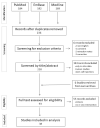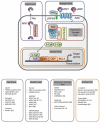Effect of Interventions in WNT Signaling on Healing of Cardiac Injury: A Systematic Review
- PMID: 33494313
- PMCID: PMC7912185
- DOI: 10.3390/cells10020207
Effect of Interventions in WNT Signaling on Healing of Cardiac Injury: A Systematic Review
Abstract
The wound healing that follows myocardial infarction is a complex process involving multiple mechanisms, such as inflammation, angiogenesis and fibrosis. In the last two decades, the involvement of WNT signaling has been extensively studied and effects on virtually all aspects of this wound healing have been reported. However, as often is the case in a newly emerging field, inconsistent and sometimes even contradictory findings have been reported. The aim of this systematic review is to provide a comprehensive overview of studies in which the effect of interventions in WNT signaling were investigated in in vivo models of cardiac injury. To this end, we used different search engines to perform a systematic search of the literature using the key words "WNT and myocardial and infarction". We categorized the interventions according to their place in the WNT signaling pathway (ligand, receptor, destruction complex or nuclear level). The most consistent improvements of the wound healing response were observed in studies in which the acylation of WNT proteins was inhibited by administering porcupine inhibitors, by inhibiting of the downstream glycogen synthase kinase-3β (GSK3β) and by intervening in the β-catenin-mediated gene transcription. Interestingly, in several of these studies, evidence was presented for activation of cardiomyocyte proliferation around the infarct area. These findings indicate that inhibition of WNT signaling can play a valuable role in the repair of cardiac injury, thereby improving cardiac function and preventing the development of heart failure.
Keywords: WNT signaling; in vivo; infarct healing; myocardial infarction; systematic review.
Conflict of interest statement
The authors declare no conflict of interest.
Figures


Similar articles
-
Therapeutic effect of a novel Wnt pathway inhibitor on cardiac regeneration after myocardial infarction.Clin Sci (Lond). 2017 Dec 8;131(24):2919-2932. doi: 10.1042/CS20171256. Print 2017 Dec 15. Clin Sci (Lond). 2017. PMID: 29162747
-
Sfrp1 protects against acute myocardial ischemia (AMI) injury in aged mice by inhibiting the Wnt/β-catenin signaling pathway.J Cardiothorac Surg. 2021 Jan 19;16(1):12. doi: 10.1186/s13019-020-01389-4. J Cardiothorac Surg. 2021. PMID: 33468190 Free PMC article.
-
Inhibition of miR-148b ameliorates myocardial ischemia/reperfusion injury via regulation of Wnt/β-catenin signaling pathway.J Cell Physiol. 2019 Aug;234(10):17757-17766. doi: 10.1002/jcp.28401. Epub 2019 Feb 28. J Cell Physiol. 2019. PMID: 30820984
-
The role of Wnt signaling in the healing myocardium: a focus on cell specificity.Basic Res Cardiol. 2018 Oct 16;113(6):44. doi: 10.1007/s00395-018-0705-y. Basic Res Cardiol. 2018. PMID: 30327885 Review.
-
Wnt Signaling in Cardiac Remodeling and Heart Failure.Handb Exp Pharmacol. 2017;243:371-393. doi: 10.1007/164_2016_56. Handb Exp Pharmacol. 2017. PMID: 27838851 Review.
Cited by
-
VCAM1 expression in the myocardium is associated with the risk of heart failure and immune cell infiltration in myocardium.Sci Rep. 2021 Sep 30;11(1):19488. doi: 10.1038/s41598-021-98998-3. Sci Rep. 2021. PMID: 34593936 Free PMC article.
-
Blockade of Wnt Secretion Attenuates Myocardial Ischemia-Reperfusion Injury by Modulating the Inflammatory Response.Int J Mol Sci. 2022 Oct 14;23(20):12252. doi: 10.3390/ijms232012252. Int J Mol Sci. 2022. PMID: 36293109 Free PMC article.
-
Pharmacological suppression of the WNT signaling pathway attenuates age-dependent expression of the phenotype in a mouse model of arrhythmogenic cardiomyopathy.J Cardiovasc Aging. 2021;1(3):10.20517/jca.2021.04. doi: 10.20517/jca.2021.04. Epub 2021 Jun 6. J Cardiovasc Aging. 2021. PMID: 34447973 Free PMC article.
-
The role of β-catenin in cardiac diseases.Front Pharmacol. 2023 Mar 22;14:1157043. doi: 10.3389/fphar.2023.1157043. eCollection 2023. Front Pharmacol. 2023. PMID: 37033656 Free PMC article. Review.
-
The WNT/β-catenin pathway regulates expression of the genes involved in cell cycle progression and mitochondrial oxidative phosphorylation in the postmitotic cardiac myocytes.J Cardiovasc Aging. 2022;2(2):15. doi: 10.20517/jca.2021.35. Epub 2022 Jan 28. J Cardiovasc Aging. 2022. PMID: 35224561 Free PMC article.
References
-
- Hausenloy D.J., Chilian W., Crea F., Davidson S.M., Ferdinandy P., Garcia-Dorado D., van Royen N., Schulz R., Heusch G. The coronary circulation in acute myocardial ischaemia/reperfusion injury: A target for cardioprotection. Cardiovasc. Res. 2019;115:1143–1155. doi: 10.1093/cvr/cvy286. - DOI - PMC - PubMed
-
- Benjamin E.J., Blaha M.J., Chiuve S.E., Cushman M., Das S.R., Deo R., de Ferranti S.D., Floyd J., Fornage M., Gillespie C., et al. American Heart Association Statistics, and S. Stroke Statistics, Heart Disease and Stroke Statistics-2017 Update: A Report From the American Heart Association. Circulation. 2017;135:e146–e603. doi: 10.1161/CIR.0000000000000485. - DOI - PMC - PubMed
Publication types
MeSH terms
LinkOut - more resources
Full Text Sources
Other Literature Sources

